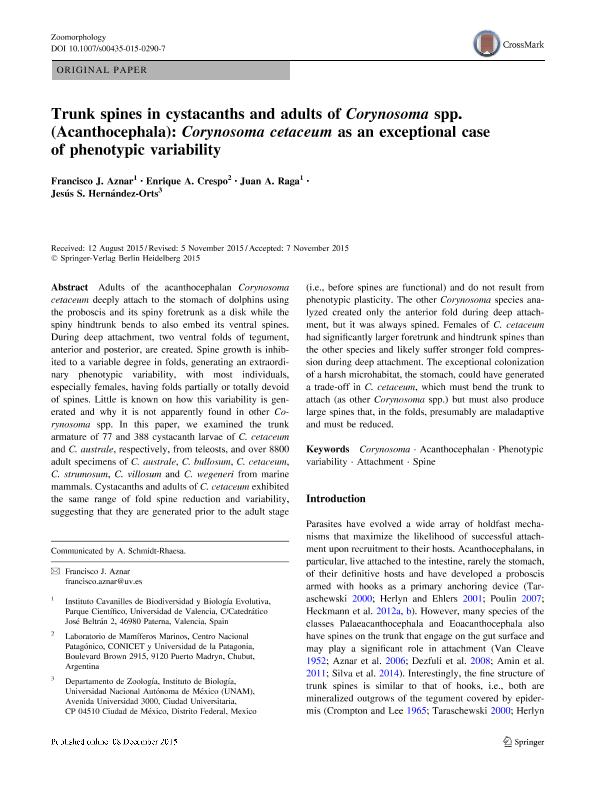Mostrar el registro sencillo del ítem
dc.contributor.author
Aznar Avendaño, Francisco Javier

dc.contributor.author
Crespo, Enrique Alberto

dc.contributor.author
Raga, Juan A.
dc.contributor.author
Hernández Orts, Jesús Servando

dc.date.available
2020-06-18T15:33:12Z
dc.date.issued
2015-11
dc.identifier.citation
Aznar Avendaño, Francisco Javier; Crespo, Enrique Alberto; Raga, Juan A.; Hernández Orts, Jesús Servando; Trunk spines in cystacanths and adults of Corynosoma spp. (Acanthocephala): Corynosoma cetaceum as an exceptional case of phenotypic variability; Springer; Zoomorphology (Berlin Print); 135; 11-2015; 19-31
dc.identifier.issn
0720-213X
dc.identifier.uri
http://hdl.handle.net/11336/107610
dc.description.abstract
Adults of the acanthocephalan Corynosoma cetaceum deeply attach to the stomach of dolphins using the proboscis and its spiny foretrunk as a disk while the spiny hindtrunk bends to also embed its ventral spines. During deep attachment, two ventral folds of tegument, anterior and posterior, are created. Spine growth is inhibited to a variable degree in folds, generating an extraordinary phenotypic variability, with most individuals, especially females, having folds partially or totally devoid of spines. Little is known on how this variability is generated and why it is not apparently found in other Corynosoma spp. In this paper, we examined the trunk armature of 77 and 388 cystacanth larvae of C. cetaceum and C. australe, respectively, from teleosts, and over 8800 adult specimens of C. australe, C. bullosum, C. cetaceum, C. strumosum, C. villosum and C. wegeneri from marine mammals. Cystacanths and adults of C. cetaceum exhibited the same range of fold spine reduction and variability, suggesting that they are generated prior to the adult stage (i.e., before spines are functional) and do not result from phenotypic plasticity. The other Corynosoma species analyzed created only the anterior fold during deep attachment, but it was always spined. Females of C. cetaceum had significantly larger foretrunk and hindtrunk spines than the other species and likely suffer stronger fold compression during deep attachment. The exceptional colonization of a harsh microhabitat, the stomach, could have generated a trade-off in C. cetaceum, which must bend the trunk to attach (as other Corynosoma spp.) but must also produce large spines that, in the folds, presumably are maladaptive and must be reduced.
dc.format
application/pdf
dc.language.iso
eng
dc.publisher
Springer

dc.rights
info:eu-repo/semantics/openAccess
dc.rights.uri
https://creativecommons.org/licenses/by-nc-sa/2.5/ar/
dc.subject
CORYNOSOMA
dc.subject
ACANTHOCEPHALAN
dc.subject
PHENOTYPIC VARIABILITY
dc.subject
ATTACHMENT
dc.subject
SPINE
dc.subject.classification
Ecología

dc.subject.classification
Ciencias Biológicas

dc.subject.classification
CIENCIAS NATURALES Y EXACTAS

dc.title
Trunk spines in cystacanths and adults of Corynosoma spp. (Acanthocephala): Corynosoma cetaceum as an exceptional case of phenotypic variability
dc.type
info:eu-repo/semantics/article
dc.type
info:ar-repo/semantics/artículo
dc.type
info:eu-repo/semantics/publishedVersion
dc.date.updated
2020-05-27T16:28:18Z
dc.identifier.eissn
1432-234X
dc.journal.volume
135
dc.journal.pagination
19-31
dc.journal.pais
Alemania

dc.journal.ciudad
Berlin
dc.description.fil
Fil: Aznar Avendaño, Francisco Javier. Universidad de Valencia; España
dc.description.fil
Fil: Crespo, Enrique Alberto. Consejo Nacional de Investigaciones Científicas y Técnicas. Centro Nacional Patagónico; Argentina
dc.description.fil
Fil: Raga, Juan A.. Universidad de Valencia; España
dc.description.fil
Fil: Hernández Orts, Jesús Servando. Universidad Nacional Autonoma de Mexico. Instituto de Biologia. Departamento de Zoología.; México
dc.journal.title
Zoomorphology (Berlin Print)
dc.relation.alternativeid
info:eu-repo/semantics/altIdentifier/url/http://link.springer.com/article/10.1007%2Fs00435-015-0290-7
dc.relation.alternativeid
info:eu-repo/semantics/altIdentifier/doi/http://dx.doi.org/10.1007/s00435-015-0290-7
Archivos asociados
